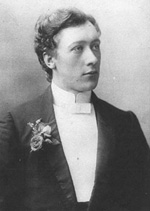In November 1965, Marjory Alexander Barlow, first generation teacher and niece to F.M., delivered the Annual Memorial Lecture for STAT*. This 6 part series is the transcript of that address.
*“In 1958, the Society of Teachers of the Alexander Technique (STAT) was founded in the UK by teachers who were trained personally by FM Alexander. STAT’s first aim is to ensure the highest standards of teacher training and professional practice.” (STAT website)
The Teaching of F. Matthias Alexander
By Marjory Alexander Barlow
Part II
Alexander began with the concrete – he had little time for theories or for ideas which had no practical application.
He was forced to his search by a disability which was interfering with his work as an actor and reciter. The problem seemed to be a specific difficulty – that of recurring hoarseness of his voice – but it led him to discover that a small and apparently isolated weakness could not be overcome without recourse to the total change of his whole self. And that attempts to change at the outer visible level – the usual way of trying to correct faults – were completely unavailing.
Here then was Alexander, a successful reciter with a passion for Shakespeare and a firm determination to become a great Shakespearean actor. All his ambitions were falling to pieces because his voice was not standing up to the demands being made upon it.
He sought medical advice. After disappointing trials of the remedies, which worked improvements only as long as he refrained from using his voice, he came to a realization which was the first stroke of genius in a long series. He understood that he might be causing the trouble himself – that he might be putting strain on the vocal organs in some way which was unknown to him. Looking back from where we stand now, this step in a new direction in thinking about his problem, stands out clearly as the key to all that was to follow and shows Alexander’s capacity for original thought and also the awkward way he had of not accepting anything at its face value. Even as a small boy this quality was evident. It is said that he was a perfect nuisance at the Dame School he attended in Tasmania because he invariably questioned everything he was taught, and asked his teachers how they knew the information they were giving him was so.
There is no means of knowing how many people with Alexander’s voice trouble have given up their careers as speakers, actors or singers because they accepted unthinkingly that, if medical treatment failed, there could be no other solution to their difficulties.
Alexander had now taken responsibility upon himself for his trouble. In order to observe what he did when he used his voice he practiced speaking in front of mirrors. By patiently watching what he was doing he found, at length, that three rather peculiar things happened every time he spoke. There was a tendency to pull the head back, depress the larynx, and suck in air through the mouth. With these interferences went a tendency to raise his chest and shorten his whole body.
After much experimentation he found that if he could prevent the pulling back of the head the other misuses did not occur.
This was the second major discovery – namely, that the inferences with the free poise of the head brought interference with the best working of the rest of his body in its train.
The dominance of the head in the hierarchy of the body he later called the Primary Control partly because, in unraveling the muddle of misuse, it is the first factor to be dealt with, and conditions the forms of misuse in the rest of the boy.
The Primary Control, in its full definition, is the relationship between the head, the neck, and the back. It is the Primary Control of the use of the body whether the use is good or bad.
Having discovered what might be causing the voice difficulties Alexander now set about trying to correct these faults in the most obvious way. He tried to DO the opposite. But the more he struggled to do the right thing the more entangled he became.
He found that he couldn’t stop these wrong habits by trying to do so. At last he realized that he hadn’t got to DO something different, but to stop what he was doing already.
This is the next important principle in his teaching which turns upside down all the accepted notions about correcting something that is wrong. Usually if something is wrong we think we must DO something to put it right.
The new principle if that is something is wrong, we must find out what it is and stop doing it. The only cure for banging one’s head against a wall is to stop.
The understanding of this principle is cardinal in any attempt to change misuse, and highlights one of the basic differences between this teaching and any other method.
It also provides a useful explanation of the work on a certain level. It can be formulated like this in answer to questions about what we do. “We teach people to become aware of the unnecessary strain and over-tension they make in everything they do, so that they need not continue to misuse themselves in this way.”
In other words we are concerned with giving our pupils the knowledge of how to liberate themselves from the cage of over-tension in which they are imprisoned. So that the free natural use of the body can emerge. Cyril Connolly wrote in The Unquiet Grave-“inside every fat man is a thin one trying to get out.” We might alter it thus, “Inside every tense man is a free one not knowing how to get out.”
We are not teaching people what to do right – but how to stop wrong DOING. It is impossible to DO an UNDOING.
